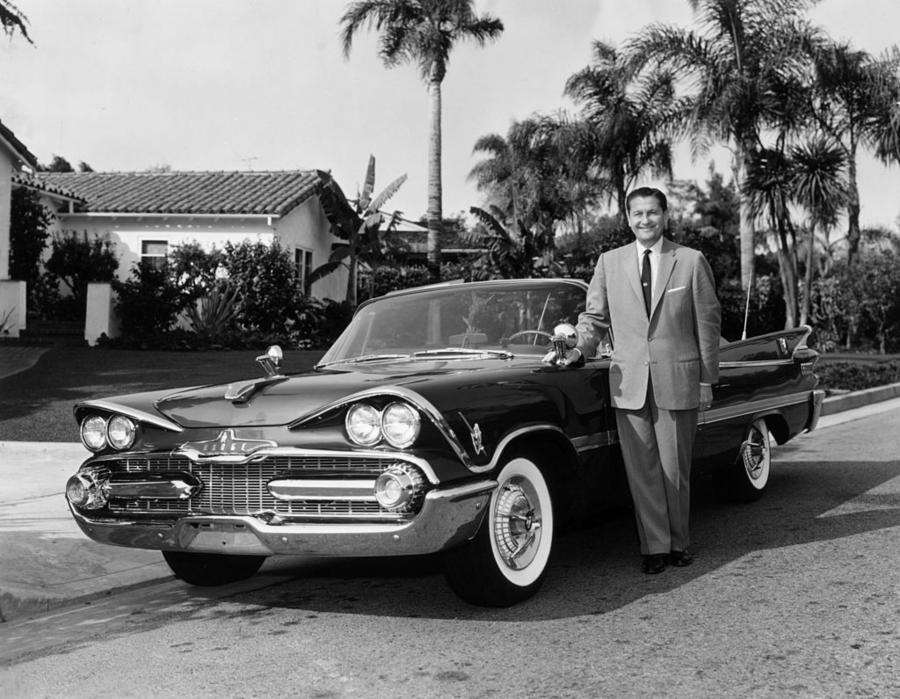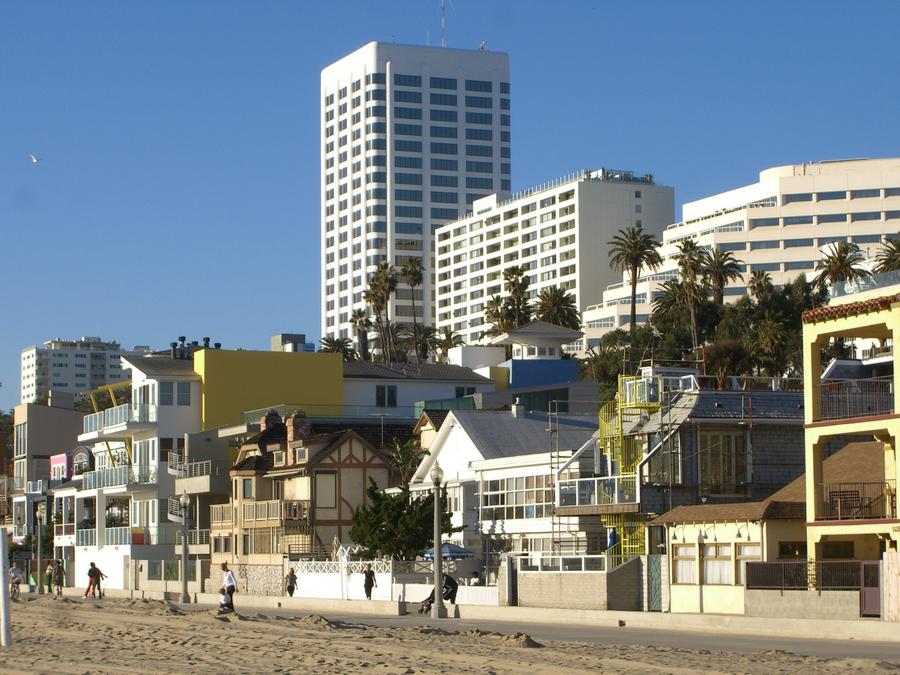When I was a little girl, I used to watch a TV show with my grandparents. The women on the show were all dressed in sorbet-colored chiffon dresses. The men wore matching tuxedos. Grandma would sing along with the old songs, and we'd dance around the living room together. Even then, though, I was aware that this magical world on the television screen was from an era long since over. The music on his long-running program was called "Champagne Music." The host of the show was named Lawrence Welk. The name of the show was, appropriately, "The Lawrence Welk Show."
Born in 1903 to German immigrant farmers in Strasburg, North Dakota, Lawrence Welk grew up speaking German as his first language. He left school after the fourth grade. His dream was simple: to become a professional musician. He convinced his father to buy him an expensive accordion (roughly $5,000 in today's money) and worked off the debt by toiling on the family farm. By his early twenties, he had formed his own band, playing polkas and waltzes at regional dances.
Fast forward a few decades and Lawrence Welk had quietly amassed one of the largest fortunes in entertainment history, far outpacing many of his more famous contemporaries. His story is one of perseverance, business acumen, and an unwavering connection with his audience…

Lawrence Welk circa 1955. (Photo by Archive Photos/Getty Images)
A $400 Accordion
Lawrence Welk was born in the German-speaking community of Strasburg, North Dakota, on March 11, 1903. He was the sixth of eight children born to German-speaking immigrants from Odesa, Russian Empire (what is today Ukraine), who moved to the United States in 1892. When the Welks moved to North Dakota, they didn't have a home and spent the first brutal winter living in an overturned covered wagon that they covered in sod to keep the cold out. The Welks eventually built a home on some farmland. Welk left school in 4th grade to help out on the family farm.
Welk's dad taught him how to play the accordion at night after the farm work was done. The family didn't have a lot of money, but Lawrence convinced his dad he was serious about a career in music, and his father ordered a mail-order accordion for $400. That's the same as around $5,000 today. It was an astronomical amount of money at the time, especially for a poor family of farmers. Lawrence slowly repaid his father for the accordion by working on the family farm and doing other side jobs.
The Lawrence Welk Band
Welk didn't learn to speak English until he was 20. A year later, he left his family home to pursue his dream of making a career in music. He performed in a number of bands in the 1920s before forming "The Lawrence Welk Band," which was hired to be the in-house band for a popular radio station in South Dakota. In 1927, Welk landed his own daily radio show, which brought him some fame as well as well-paying gigs throughout the Midwest. He graduated from the MacPhail School of Music in Minneapolis in 1927. He continued to do the radio show until 1936.
The Lawrence Welk Show
In 1951, Welk moved to Los Angeles, where he and his band, "The Champagne Music Makers," played a four-week gig in the spring of 1951.
That same year, Klaus Landsberg, the manager of the local L.A. television station KTLA, offered Welk a television show. Starting on May 11, 1951, "The Lawrence Welk Show" was broadcast live from the Aragon ballroom once a week.
His signature style—light orchestral music, bubbly visuals, and a meticulously clean-cut aesthetic—quickly gained traction. Welk was known for starting his performances with the now-famous line "ah-one an' ah-two." In 1955, The Lawrence Welk Show was picked up by ABC. The show ran for 16 years on ABC. It was canceled in 1971 after ABC's advertisers complained that the show's audience was "too old."
The First Brilliant Move
Welk's audience may have been old, but they were also ferociously loyal. When ABC pulled the plug, over one million fans bombarded the network with letters and phone calls in protest.
Welk believed his show still had a viable audience. Understanding his unique position, Welk made a bold, unheard-of move: he syndicated the show himself. Instead of relying on a major network, he cut direct deals with 250 stations across the country. It worked. The show remained on the air for another 11 years, bringing in millions in ad revenue and solidifying Welk's financial independence. At its peak, the new syndicated version of "The Lawrence Welk Show" appeared on 250 stations across the US – far more than it had when it was airing on ABC. For many, many years, seeing Welk and his band perform live was the second-most popular tourist attraction in Los Angeles. Only Disneyland was more popular.
It gets better.
While many entertainers of his era depended solely on performance income, Welk had a business-first mentality that set him apart. He owned his show outright, meaning that every dollar from syndication, commercials, and merchandise went directly into his pocket. He also retained control over his master recordings, a rarity in the music industry. In the early 1960s, he negotiated a lucrative distribution deal with Dot Records while keeping the rights to his albums. By the 1970s, he even bought back his catalog and launched his own label, Ranwood Records, ensuring that record sales benefited him, not a third party.
At his peak in the 1960s and 1970s, Lawrence Welk was earning roughly $3 million per year from his show. That's the same as making $30 million per year today.
It gets better.

Photo by Hulton Archive/Getty Images
Side Investment Becomes an Empire
After growing up in landlocked North Dakota, upon moving to LA, specifically Santa Monica, Lawrence became obsessed with ocean views. Starting in the early 1960s, Welk invested some of his TV money into undeveloped ocean-view land in Santa Monica.
On one of his properties, he built what is still the tallest building in Santa Monica, located at 100 Wilshire Boulevard. For many years, the building was called "Lawrence Welk Plaza."
He then built a 16-story luxury residential "Lawrence Welk Champagne Towers" right next door at 1221 Ocean Avenue. Today, you can rent an apartment in that building for between $10,000 and $20,000 per month. Welk's private residence was the penthouse at 1221 Ocean. He also built 1299 Ocean Avenue, an 11-story office complex next door, which is called "The Wilshire Palisades" today.
In 1987, Welk sold 100 Wilshire to a Japanese company called Asahi Urban for $73 million. That's the same as $205 million today.
The Champagne Towers suffered significant damage in the 1994 Northridge Earthquake. It sat vacant for several years before being acquired in 1998 for $44 million. In April 2022, Irvine Company sold 1221 Ocean Avenue to Douglas Emmett Inc., a Santa Monica-based REIT, in a joint venture with a partner. The sale price was $330 million (about $2.75 million per unit), setting a record on a per-unit basis for Santa Monica.
The Welk family sold 1229 Ocean Avenue, The Wilshire Palisades, for an undisclosed amount in 1998. The office tower eventually became part of Equity Office Properties Trust. It was then acquired by Blackstone Group in 2007. In April 2017, Blackstone sold 1299 Ocean Avenue to a joint venture of Douglas Emmett Inc. and the Qatar Investment Authority. The sale price was around $248 million (about $1,205 per sq. ft.), one of the highest on record for Santa Monica offices at the time.
You can see all three buildings in the photo below. 100 Wilshire is the skyscraper. The residential complex at 1221 Ocean is the next building over. The Wilshire Palisades office complex is the next one over:

Photo by Erik Frederics vis Flickr (CC BY-SA 2.0)
The Welk
In 1964, against his advisors' suggestions, he purchased a struggling trailer park and golf course near San Diego. In 1979, the company spent $12 million upgrading it from a small mobile home park to a 1,000-acre resort and retirement complex with a hotel, restaurant, shopping, museum, golf course, and 450 mobile homes. At its peak, 40,000 people a month visited this development. Known today as "The Welk," it is a family-friendly luxury resort operated by Hyatt:
The Richest Entertainer of His Time
By the time of his death in 1992, Welk was worth an estimated $150 million. That made him far richer than Elvis Presley, Frank Sinatra, or even Bob Hope. Adjusted for inflation, Lawrence Wel was worth $275 million in today's dollars.
Legacy
Welk has two stars on the Hollywood Walk of Fame which were awarded to him in 1960. One is for Television at 1601 Vine Street, and the other is for Recording at 6613 Hollywood Boulevard. In 1996, he was ranked #43 on the TV Guide list of the 50 Greatest TV Stars of All Time.
Despite his immense fortune, Welk never strayed from his persona as a modest, old-fashioned entertainer. He continued performing into his 80s, and his business empire flourished beyond his passing. Today, reruns of The Lawrence Welk Show still air on PBS, and his investments in resorts and real estate continue to generate revenue.
The biggest takeaway from Welk's story? He understood the power of ownership. He owned his show. He owned his music. He owned his real estate. While many artists of his era ended up broke due to bad deals, Welk flipped the script and built an empire that outlived him. His career and business strategy remain a blueprint for entertainers who seek to control their financial destiny.
Lawrence Welk may have played "square" music, but when it came to business, he was as sharp as they come.
Welk was married for 61 years, from 1931 until his death, to Fern Veronica Renner. They had three children, 10 grandchildren, and one great-grandchild. He retired from public life in 1992 and died of pneumonia at his Santa Monica penthouse on May 17, 1992. He was surrounded by his family at the time of his death.
Lawrence Welk parlayed being an accordion player from North Dakota into a television and real estate career that made him at least $150 million by the time he died. Adjusted for inflation, that would be equal to $277 million today. It seems we could all learn a little something from him, his "Champagne Music" and his catchphrase "ah-one an' ah-two." He had two careers that were both wildly successful.
/2020/09/lawrence.png)
/2018/02/gw.jpg)
/2019/05/bob-hope.jpg)
/2019/03/colonel.jpg)
/2009/12/Dick-Clark.jpg)
/2009/09/oprah2.jpg)
/2016/02/GettyImages-2107467-e1579977819418.jpg)
/2019/08/ng.jpg)
/2010/02/Ron-Jeremy.jpg)
:strip_exif()/2020/06/taylor.png)
/2015/01/GettyImages-512607330.jpg)
/2010/01/GettyImages-149907344.jpg)
/2020/01/Tammy-Faye-Messner.jpg)
/2019/09/af.jpg)
/2012/04/Pat-Robertson-1.jpg)
/2019/09/Taylor-Fritz.jpg)
/2014/04/GettyImages-909023006.jpg)
/2015/12/GettyImages-56543209.jpg)
/2010/09/Tony-Curtis-pic.jpg)
/2021/12/mlk.jpg)
/2020/01/lohan.jpg)
/2021/09/Jessica-Hahn.jpg)
/2020/05/kandi-1.jpg)